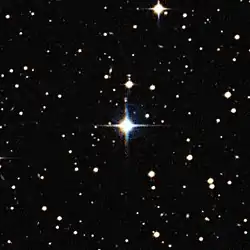HD 197027
HD 197027 (HIP 102152) is a star in the constellation Capricornus that is located about 250 light years from the Sun.
 HIP 102152 Credit: ESO/Digitized Sky Survey 2 | |
| Observation data Epoch J2000 Equinox J2000 | |
|---|---|
| Constellation | Capricornus |
| Right ascension | 20h 41m 45.632s[1] |
| Declination | −27° 12′ 57.414″[1] |
| Apparent magnitude (V) | 9.18 |
| Characteristics | |
| Spectral type | G3V[1] |
| B−V color index | +0.65[1] |
| Astrometry | |
| Radial velocity (Rv) | -44.3[1] km/s |
| Proper motion (μ) | RA: +172.91[1] mas/yr Dec.: -15.41[1] mas/yr |
| Parallax (π) | 12.84 ± 0.97[1] mas |
| Distance | 250 ± 20 ly (78 ± 6 pc) |
| Absolute magnitude (MV) | 4.72 |
| Details | |
| Mass | 0.97[2] M☉ |
| Surface gravity (log g) | 4.40±0.02[3] cgs |
| Temperature | 5718±5[3] K |
| Metallicity [Fe/H] | −0.020±0.005[3] dex |
| Rotational velocity (v sin i) | 1.78±0.12[3] km/s |
| Age | 6.92±0.69[3] Gyr |
| Other designations | |
| Database references | |
| SIMBAD | data |
The measured properties of this star are very similar to those of the Sun, making it a candidate older solar twin.[4] The abundances of 21 elements overall are more similar to the Sun than any other known solar twin. Additionally, the effective temperature, surface gravity, and microturbulence are nearly identical to the Sun's. However, it is significantly older than the Sun, being approximately 2.2 billion years older than the Sun, at 6.9 billion years old. The fact that the abundances are so similar to the Sun's suggests that it is a potential candidate for hosting terrestrial type planets.
Age
.jpg.webp)
The age of HD 197027, here annotated as HIP 102152, shown relative to the Sun, the younger solar twin 18 Scorpii and the formation of the Milky Way
References
- "HD 197027". SIMBAD. Centre de données astronomiques de Strasbourg. Retrieved 2013-09-07.
- Talawanda R. Monroe; et al. (Aug 2013). "High Precision Abundances of the Old Solar Twin HIP 102152: Insights on Li Depletion from the Oldest Sun". Astrophysical Journal Letters. 774 (2): L32. arXiv:1308.5744. Bibcode:2013ApJ...774L..32M. doi:10.1088/2041-8205/774/2/l32.
- dos Santos, Leonardo A.; et al. (August 2016), "The Solar Twin Planet Search. IV. The Sun as a typical rotator and evidence for a new rotational braking law for Sun-like stars", Astronomy & Astrophysics, 592: 8, arXiv:1606.06214, Bibcode:2016A&A...592A.156D, doi:10.1051/0004-6361/201628558, A156.
- ESO, The life cycle of a Sun-like star (annotated), from European Southern Observatory, 28 August 2013
External links
- Oldest Solar Twin Identified
- HIGH PRECISION ABUNDANCES OF THE OLD SOLAR TWIN HIP 102152: INSIGHTS ON LI DEPLETION FROM THE OLDEST SUN
- Oldest Solar Twin Identified
This article is issued from Wikipedia. The text is licensed under Creative Commons - Attribution - Sharealike. Additional terms may apply for the media files.